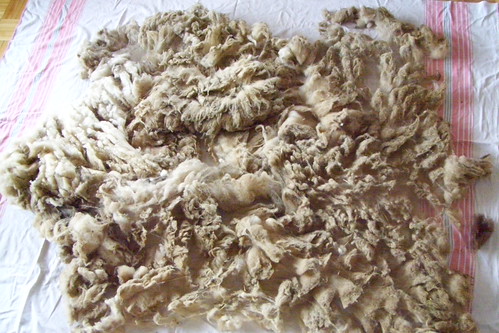 The sheep's name is Eshme, and she's a light grey Shetland.
The sheep's name is Eshme, and she's a light grey Shetland. I've sorted the fleece roughly by body-location, and have begun experimenting with scouring it in the tub (blogged). Any tips/tricks/advice for doing right by this pretty Shetland fleece would be greatly appreciated!
Also, I'm wondering what your favorite/preferred methods for fleece preparation are: flicked, Viking combed, hand-cared, drum carded, something else? Right now I'm working with a pet brush as a flick carder, and doing mini test-spins with a drop-spindle, but I've got 3lbs here! Please share your words of wisdom!




3 comments:
This is something I have really no experience with. I just bought my first fleece last month and shipped it off to Spinderella's to be cleaned and processed into roving. I'm anxious to see what you learn!
Well I am still learning myself :) but I mainly use fleece as we have so many farmers around us here with various breeds .
Well, you have learnt more than I did with my first fleece & that is that some parts are better than others on one fleece :)and that its good to separate them.
Regarding carding all I can say really is,it depends on each fleece as to how I card, how long the staple is etc. I do have a drum carder and hand carders but sometimes a fleece especially one like a Shetland can be spun straight from the fleece whilst others like a Teeswater I would flick card it to keep the long staple and spin it worsted .
Not much help am I ?
It does look a lovely fleece though and I do love spinning Shetland as it so soft.
I have just come with '3 bags full 'of Welsh Black shearlings today !!
When I purchased my first fleece I decided I was going to try to process it myself. After reading a bunch of stuff - including the Aldon Amos book which is a spinner's bible - this is the process I used for the 2/3 I scoured before I ran out of patience:
Fill either your sink or a plastic tub that fits in your sink with 120+ degree water (the temp is important since the grease in the wool will break down at that temp - use boiled water to help raise it if necessary). While the sink is filling, separate about 1 lb of fiber to be washed (small batches are way easier to handle) and, if you have one, put it in a mesh lingerie bag. After you have the amount of water you want, add 1/4 cup of blue Dawn dish detergent. Swish the soap around v-e-r-y gently, then add the partial fleece to the water and let it soak for about 15 min. Remove the fiber from the water, let it drain out and then repeat the process at least one more time - more depending on how dirty the fleece is. THEN you get to rinse it the same way - fill the sink, no soap, at least twice. I like to add lavender scented hair conditioner to the final rinse which theoretically will help with moths ;o)
If you have a top-loading washing machine you can use that to do the whole fleece at once (with no agitation) and spin it out when you're done (make sure you use the mesh bags). If you don't have the washer, you get to spin the bag over your head if you can to get out the extra water (which is fun for the whole family *g*).
After the excess water is removed, spread the fiber out on a screen or a towel in the sun to dry. Alden also talks of thwacking with sticks if you have lots of VM...
You can also google 'scouring a fleece' (with quotes) which should turn up some more info - doing lots of research is a good thing when it comes to this since there are tons of different opinions.
Hope this helps ;o)
Oh, I'd also like to point out that I scoured 2/3 of my first fleece myself and ended up getting the whole thing processed - my 2nd fleece I sent out immediately. Scouring (and then the carding - never forget the carding) is A LOT of work.
Post a Comment